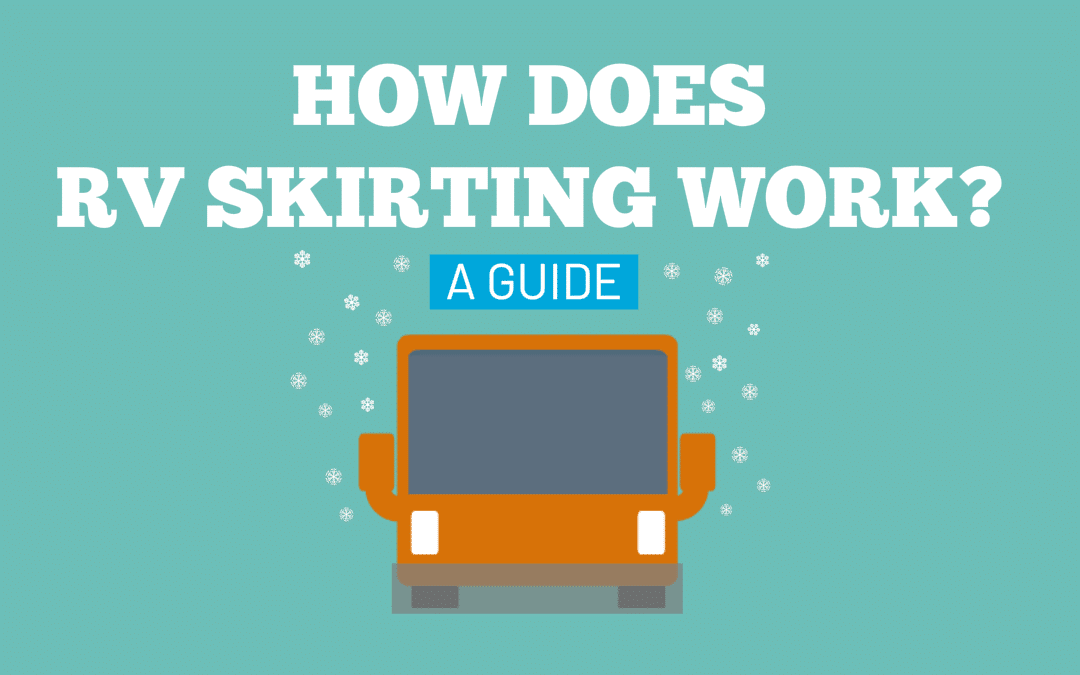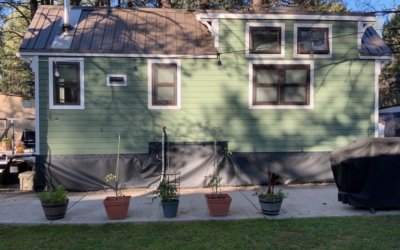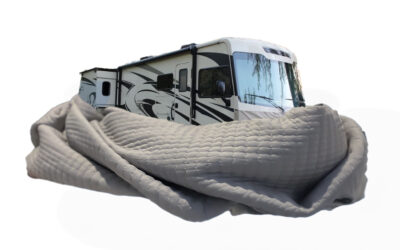RV skirting keeps the undercarriage of an RV warm by sealing it off from the outside air.
Once the air underneath an RV is contained it can be heated, which is what protects the pipes and tanks.
RV skirting acts like a container for heat.
If you were to put a heater under your RV without any skirting on, there would be no benefit because the heat would blow away.
Is RV skirting worth the cost?
If you full-time in an RV during the winter, think of RV skirting as an investment in peace of mind.
The main issue for RVs in cold temperatures is that the pipes can freeze.
Water expands when it freezes so if there is water inside a pipe that freezes then there’s a good chance it will burst.
And if it’s cold enough for the water to freeze, then it also could mean that the pipes have burst in multiple spots.
Even more frustrating is that calling a plumber for RV repairs is not easy because a lot don’t work on RVs.
Taking your RV to a repair shop is an option, but it’s expensive and a huge hassle if you live in it full time.
Having burst pipes also means living without running water until the repairs are done.
Installing skirting is the most effective way of protecting your RV.
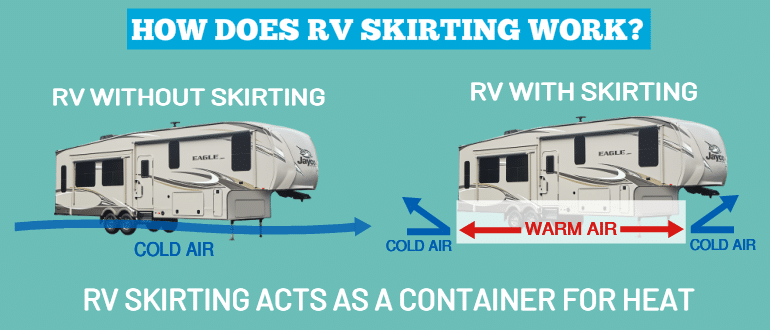
Why do pipes freeze on an RV?
Most RV’s are not designed for winter living so the pipes are usually either exposed or not insulated enough.
The pipes found in a house are usually well protected, so it’s a lot harder for them to reach freezing temperatures.
Winter living in an RV usually requires a lot of customization and DIY solutions.
What if my RV has an arctic or four season package?
Even with a cold weather upgrade your RV may still be at risk.
That’s because there is no industry standard for RV winter package options so they can vary wildly in quality.
Some can live out the winter with no problems, and others can get frozen pipes despite having an arctic option.
Unless you know someone who has the same model and has gone through a winter with no issues, it can be hard to know if your RV will be able to withstand freezing temperatures.
How does RV skirting prevent pipes from freezing?
RV skirting works by enclosing the air underneath your RV.
Once you have enclosed that air, you can warm it up and the heat won’t dissipate because it’s been contained.
RV skirting acts like a barrier from the cold air outside and a container for the warm air inside.
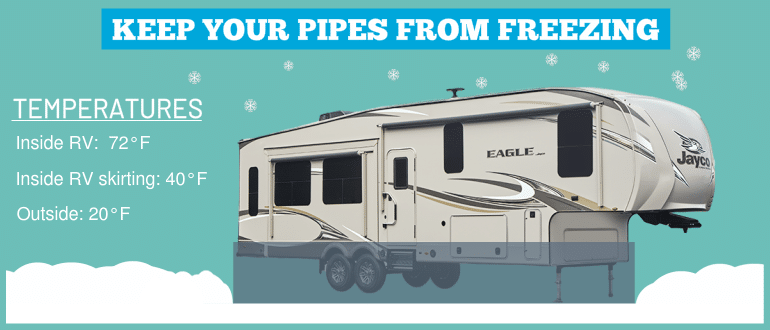
Is insulated RV skirting worth it?
This is one of the biggest RV skirting misconceptions.
RV skirting does not need to be insulated or have any R-value.
The effectiveness of insulation is measured in R-value.
It’s the measurement for a material’s resistance to heat flow.
The higher the R-value, the better the material is at blocking the flow of heat.
The issue with R-value and RV skirting is that you don’t need any R-value at all to prevent frozen pipes.
The most important job of RV skirting is to stop air infiltration.
Air infiltration is the passage of air in or out of an enclosed space.
Stopping air infiltration on an RV is done by sealing off the bottom with skirting.
Once the air is trapped it can be heated.
That heated, contained air is what protects the pipes from freezing.
The main reason why you don’t need R-value for RV skirting is because you don’t need to keep your RV underbelly as warm the interior of the RV.
No one is living under there, so the temperature doesn’t need to be kept in the 70s.
It just needs to be kept warm enough so that nothing will freeze.
Imagine leaving the windows and doors open in a house in the middle of winter.
It wouldn’t matter how good the insulation is, the house would be freezing because the cold air is coming inside.
A house can only get warm and stay warm by sealing it off from the air outside.
RV skirting works in the same way.
Once the air is sealed off it can be heated.

Insulated RV skirting, or sometimes called quilted RV skirting, doesn’t provide any meaningful extra protection.
The thickness of insulation found in insulated RV skirting is too thin to make any real difference in R-value.
The job is RV skirting is to stop air infiltration, so to pay extra for insulation that doesn’t do a whole lot is not worth the extra expense.
Now that I have RV skirting, what next?
First, mount the skirting so that there aren’t any large openings or gaps where cold air can get in.
Second, place two temperature controlled heaters at both ends of the RV and set them to just above freezing.
This way they only turn on and stay on as long as needed to warm things up.
Place them on cookie trays so they aren’t sitting directly on the ground and invest in heaters that have a tip-over safety switch as well.
Does RV skirting have any other benefits?
There are lots of advantages to having skirting. It’s the type of investment that pays for itself in a variety of ways.
Here are just a few of the benefits from having RV skirting:
- A warmer, more comfortable living space
-
Save money on propane costs
-
Use your tanks all winter
- Prevent tire dry rot
- Extra storage
- Protect pipes from freezing
More comfortable living space
Keeping the underside of your RV above freezing will help keep your RV warmer too.
Sealing off the underside of an RV essentially creates an extra layer of insulation.
Warmer floors and a warmer cabin can make a big difference in comfort during the winter months.
Save money on propane
It goes without saying that because your floor and cabin are kept warmer by skirting, you’ll have to spend less to heat your RV.
Any RVer who’s ever full-timed through an extremely cold winter knows how much propane one family can go through just to stay warm.
By skirting an RV, that cost can be cut down.
Add that up year after year and it can be a significant savings.
Use your tanks all winter
Some RVers will winterize their rig so they don’t have to worry about frozen pipes.
That involves draining all the pipes and tanks, blowing them out to remove any water and then filling the lines with antifreeze.
It’s a way to guarantee no frozen pipes, but it also means living without running water.
That means frequent trips to get water and lugging it back to the RV, as well as only being able to use the on-site bathroom and shower.
Using RV skirting gives you the freedom to be able to use your tanks all winter.
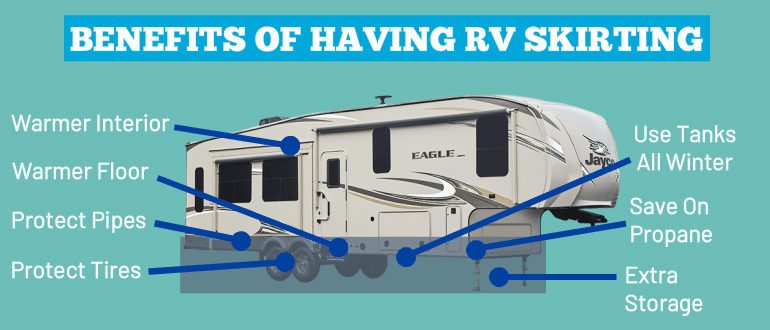
Prevent RV tire dry rot
Tire dry rot is one of the most common problems for RVers.
It’s when a tire dries out and cracks, making it unsafe to drive on.
Once a tire has dry rot there’s no way to undo it.
Dry rot happens in RV tires for two main reasons:
When tires are exposed to direct sunlight (UV rays) for long periods of time and when tires don’t get moved often enough.
Direct exposure to UV is a major factor for tire degradation.
Having RV tires sitting in direct sunlight for months on end will dry them out and accelerate dry rot.
Covering tires from harmful UV rays is one of the best ways to prevent dry rot.
If you are skirting your RV, make sure that your skirting covers your tires as well.
This one small step can extend the life of your tires by years.
Moving your tires regularly can also help prevent dry rot.
Tires are designed to be driven and there are compound resins in a tire that get released when they’re used that keep them pliable.
If you are using an RV skirting, choose one that can be easily removed and mounted again so that you can periodically move your RV and take it on the road.
This will release those compound resins and keep it flexible.
Having RV skirting that’s easy to remove and remount will make this step a lot easier.
Combining these two preventative measures together, using RV skirting and moving your RV regularly, will help stop tire dry rot in its tracks.
More storage
Space is always an issue with RV living.
By skirting an RV, you now have the entire undercarriage to use as a storage space.
What materials to use for do-it-yourself RV Skirting?
RV skirting is anything that seals off the undercarriage of an RV.
There is no standard type of RV skirting, so a lot of different types of materials can be used.
The most common materials used for do-it-yourself RV skirting are:
- Rigid foam insulation panels
- Sheets of plywood
- Hay bales
- Snow
- Vinyl skirting
Rigid Foam Insulation
Using rigid foam insulation boards is one of the most popular choices for RV skirting.
It’s inexpensive, easy to cut and easy to install.
The biggest problem with foam insulation is that the panels are so light they can easily blow off.
They need extra reinforcement to keep them attached.
That’s done by building a frame and then mounting the foam panels to it.
If your RV park has rules about aesthetics you’ll also need to put in some extra work because the insulation panels can be an eyesore on their own.
It’s the type of project that is a lot of work up front and only makes sense if you are staying in one spot for years.
If you see yourself moving at any point in the near future it would likely mean leaving your frame and insulation behind as it would be too big to bring with you.
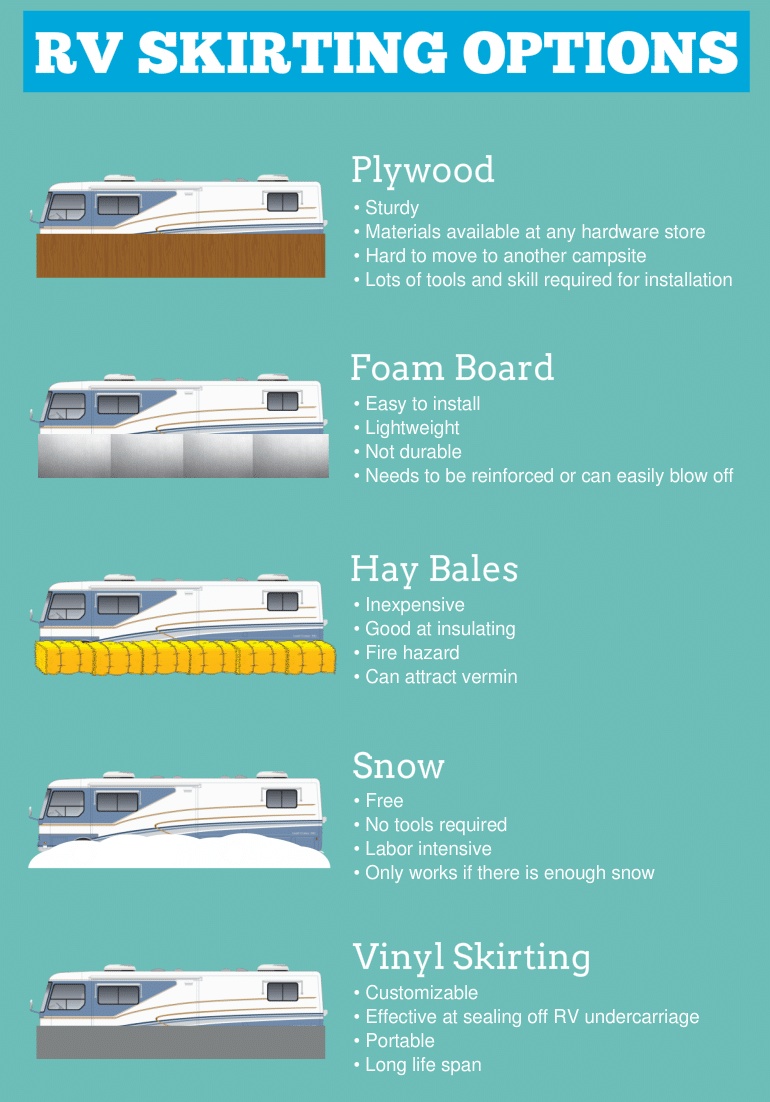
Plywood
Installing large sheets of plywood is another common option for skirting.
It’s durable, fairly inexpensive and readily available.
Because plywood is heavy, it doesn’t need a frame built for it like foam insulation.
There also isn’t a lot of skill or tools required so it can be mounted quickly and easily.
A lot of home improvement stores will even cut your plywood for free.
But just like with the foam board, plywood can be unsightly as well and may require extra work to meet RV park standards.
Plywood is extremely heavy, so it’s another option that would only make sense to use if you never planned on moving.
Hay Bales
Hay bales are extremely affordable and insulate well, so a lot of people use them for RV skirting.
However, hay bales aren’t recommended because they have two very large drawbacks.
First, they are a fire hazard.
Hay is extremely flammable.
It doesn’t take much to set it ablaze, and the fire can move from bale to bale quickly making it very dangerous to use as skirting.
Second, hay also attracts vermin.
Using it could mean inviting a mouse infestation and all the issues that come with that.
Hay may be extremely inexpensive, but it’s not worth putting your safety at risk.
Snow
By far the cheapest skirting material you could use is snow.
It’s totally free, and by piling and packing snow around the base of the house it can be an effective skirting.
But it only works if you have enough snow all winter long.
There aren’t a lot of options if the temperature drops to freezing and there’s no snow on the ground.
It’s the kind of solution that works well when everything is the best case scenario, but that’s taking a big risk.
You don’t want to find yourself having to build a makeshift skirting in the freezing cold in the middle of winter.
The money you save by using snow might not be worth the stress and hassle that comes with it.
Vinyl
The best value for price and performance is using vinyl as your skirting.
Vinyl skirting for an RV is the most practical solution because it’s lightweight versatile, and looks great when it’s installed.
It’s easy to customize to fit your RV and terrain, and if you ever plan on moving spots it can be rolled up and brought along for the ride without taking up a lot of space.
There are a lot of varieties of skirting available, with multiple different ways to mount it, so it can be hard to know what is the best choice.
EZ Snap makes the process of buying RV skirting easy.
All you have to do is measure the length of your RV, enter your numbers into the kit size calculator and order the appropriate kit from their website.
Installing EZ Snap is straightforward and can be done in as little as a day.
RV skirting is what will protect your RV from freezing, so think of it as a long term investment that is worth your time and money.
While not traveling in your RV, the use of RV covers is highly recommended to keep your RV protected from the elements. Keeping rain, damaging UV rays, dust, dirt and anything else the wind can carry, off your vehicle.
